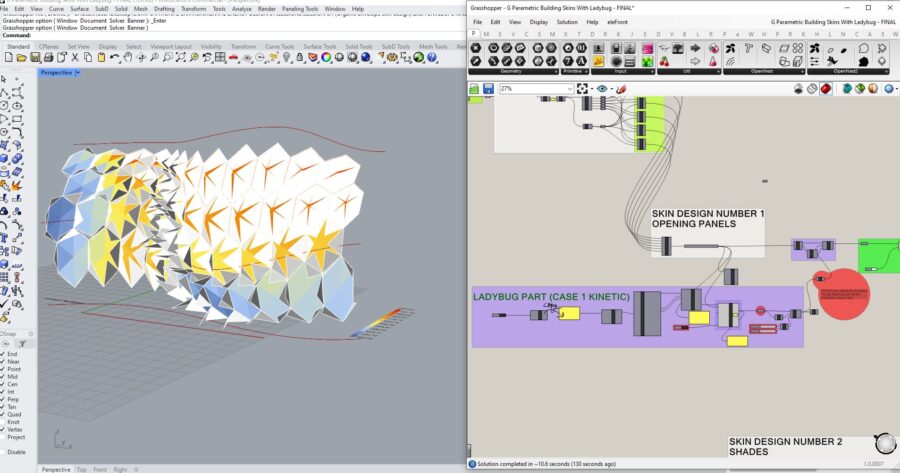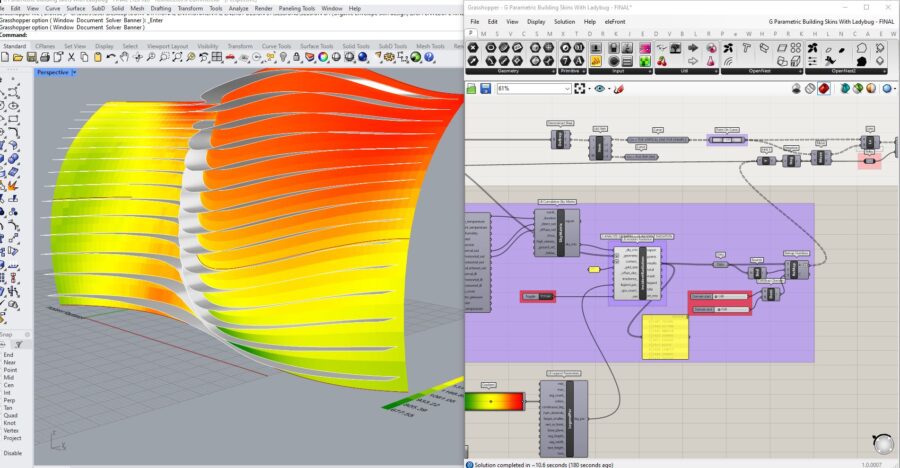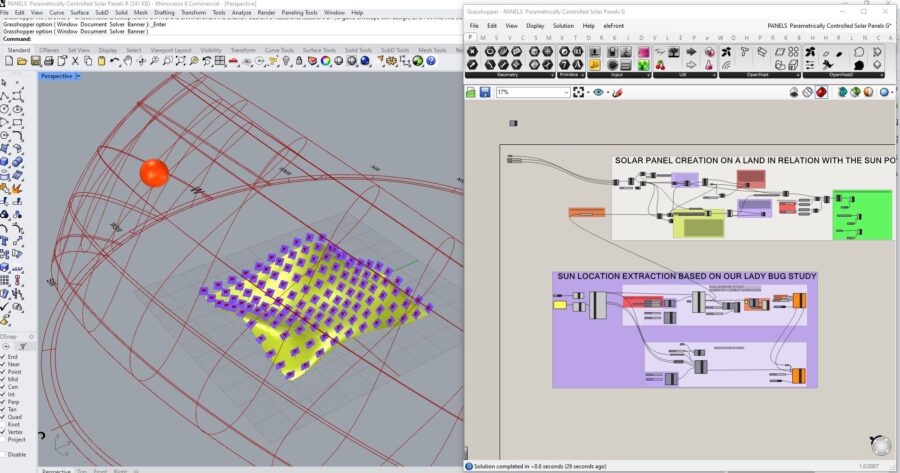Ladybug and Honeybee for Computational Environmental design and LEED Certification:
Steps in your green building process
BY JOSEPH AZAR
March 2025

Introduction: The Role of Computational Environmental Design in Sustainable Architecture
The urgency of climate change and resource conservation has transformed architecture from a purely aesthetic pursuit into a discipline grounded in performance and data. Today, sustainability is not just a concept—it is a measurable and integral part of modern building design. This shift has led to the adoption of advanced computational tools that simulate, analyze, and optimize environmental performance from the earliest stages of design.
Among the most powerful tools in this field are Ladybug and Honeybee, open-source plugins for Grasshopper in Rhino. These tools allow architects and engineers to conduct precise environmental analyses, predicting building performance across key parameters like energy efficiency, daylighting, and thermal comfort. This data-driven approach not only improves design outcomes but also helps projects meet global standards like LEED (Leadership in Energy and Environmental Design).
Integrating Ladybug and Honeybee into architectural workflows enhances the ability to meet LEED requirements with precision. These tools empower designers to make informed, performance-based decisions that align with sustainability goals without compromising aesthetic or functional integrity.
The Intersection of Ladybug, Honeybee, and LEED Certification
LEED certification is structured around several credit categories that evaluate a building’s energy use, water consumption, indoor environmental quality, and ecological impact. Ladybug and Honeybee facilitate compliance with LEED standards by providing real-time environmental data and advanced simulations.
By bridging parametric design and environmental analysis, these tools enable designers to test and refine their strategies in response to actual site conditions. This approach moves beyond intuition and allows for quantifiable, evidence-based design. Below is an in-depth exploration of how Ladybug and Honeybee support specific LEED credit categories.
LEED Credits Supported by Ladybug and Honeybee
1. Energy and Atmosphere (EA) – Optimize Energy Performance
The Energy and Atmosphere category emphasizes reducing operational energy consumption. Honeybee integrates seamlessly with EnergyPlus and OpenStudio, industry-standard simulation engines that allow for comprehensive energy modeling. These tools provide insights into:
- Envelope performance: Evaluating U-values, glazing ratios, and shading effectiveness.
- HVAC optimization: Analyzing heating, cooling, and ventilation loads.
- Passive design strategies: Assessing natural ventilation, thermal mass, and night cooling.
Using Honeybee to model and optimize energy performance helps projects earn LEED EA Credit: Optimize Energy Performance, which rewards buildings that exceed ASHRAE 90.1 energy efficiency baselines.

2. Indoor Environmental Quality (IEQ) – Daylighting and Thermal Comfort
LEED prioritizes Indoor Environmental Quality to enhance occupant well-being and productivity. Ladybug and Honeybee provide robust analysis tools for daylighting and thermal comfort.
a) Daylight Analysis (IEQ Credit: Daylight)
Honeybee uses Radiance to simulate daylight performance, enabling the calculation of:
- Spatial Daylight Autonomy (sDA): Evaluates how much natural light a space receives annually.
- Annual Sunlight Exposure (ASE): Identifies areas vulnerable to excessive glare.
By optimizing daylight distribution and minimizing glare, projects can earn daylighting credits while reducing reliance on artificial lighting.
b) Thermal Comfort Analysis (IEQ Credit: Thermal Comfort – Design)
Using Ladybug’s thermal comfort models (e.g., PMV and PPD), designers can assess:
- Seasonal thermal variations and HVAC system performance.
- The effectiveness of adaptive comfort strategies like natural ventilation.
This analysis supports compliance with ASHRAE 55, a key requirement for thermal comfort credits.
3. Sustainable Sites (SS) – Site and Climate Analysis
Ladybug’s climate visualization capabilities provide critical insights for Sustainable Sites credits. These analyses optimize site-specific strategies that reduce environmental impact.
a) Heat Island Reduction (SS Credit: Heat Island Reduction)
Ladybug can model solar radiation to evaluate the effectiveness of:
- Cool roofs and high-SRI materials.
- Vegetation-based shading and green roofs.
b) Site Development (SS Credit: Protect or Restore Habitat)
Ladybug assists in optimizing site selection by analyzing:
- Solar exposure and shadow studies.
- Prevailing wind patterns and microclimatic conditions.
These analyses support the integration of ecologically responsible design strategies.
4. Water Efficiency (WE) – Outdoor Water Use Reduction
Ladybug’s climate-based analysis supports water conservation by evaluating rainfall patterns and evapotranspiration. This data informs:
- Efficient irrigation design through rainwater harvesting and native landscaping.
- Compliance with LEED WE Credit: Outdoor Water Use Reduction, which requires minimizing potable water consumption for landscaping.
5. Water Metering and Irrigation Systems
Ladybug also assists in designing advanced metering strategies to comply with LEED’s Building-Level Water Metering prerequisite. This includes:
- Irrigation metering for outdoor water use.
- Indoor fixture monitoring to track potable water consumption.
For maximum LEED points, metering should cover at least 80% of water consumption across major systems.
6. Innovation in Design (ID) – Advanced Sustainability Strategies
LEED recognizes exceptional performance beyond its standard criteria through Innovation in Design (ID) credits. Ladybug and Honeybee allow for cutting-edge sustainability initiatives, including:
- Adaptive façade design that responds to real-time climate data.
- Carbon footprint assessments using life-cycle analysis.
- Resilient design strategies that address future climate risks.
These innovative approaches demonstrate advanced environmental stewardship, earning additional LEED points.
7. Cooling Towers – Managing Water Efficiency
Cooling tower optimization is another critical component for LEED water efficiency credits. Honeybee enables modeling of:
- Cycles of concentration for reduced blowdown.
- Water reuse strategies within HVAC systems.
By fine-tuning cooling tower operations, projects can reduce potable water consumption while maintaining thermal performance.
The Future of Computational Environmental Design in Architecture
As the demand for carbon-neutral and regenerative architecture grows, computational tools like Ladybug and Honeybee will play an increasingly vital role. These platforms empower architects to:
- Test and refine design strategies in real time.
- Visualize and optimize climate-responsive solutions.
- Enhance occupant comfort while minimizing environmental impact.
By integrating performance-based workflows into both design and teaching, I ensure that sustainability is not just a compliance exercise but a core principle guiding every decision.

Conclusion: Beyond LEED – A Holistic Approach to Sustainable Design
While LEED certification remains a globally recognized standard, true sustainability transcends rating systems. Ladybug and Honeybee offer architects the ability to push the boundaries of environmental design—moving beyond checklist compliance to create buildings that are adaptive, efficient, and human-centered.
As an architect specializing in computational environmental design, I leverage these advanced methodologies to guide projects toward innovative, sustainable solutions. Whether optimizing energy performance, improving daylighting, or ensuring thermal comfort, my practice integrates cutting-edge tools to deliver architecture that is both technically rigorous and aesthetically compelling.
Through these tools, we can shape a future where buildings are not only sustainable but are also active participants in improving our environment.

Artist/Architect/ LEED AP (BD+C)
Computational/ Environmental design
Enjoyed this article? Discover more in the Blog section
